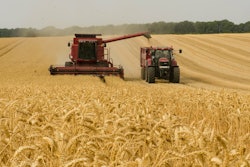
The economic impacts of the Russian-Ukrainian conflict on U.S. agriculture could last much longer than people might expect, a senior economist for the Federal Reserve Bank of Kansas City said.
Cortney Cowley, who works out of the bank’s Regional Affairs Department with offices in Oklahoma City, discussed the war’s effects while speaking at the Kansas Grain & Feed Association annual meeting April 12 in Wichita, KS.
“We need to right now start thinking about this in terms of years and not months or weeks,” said Cowley. “Even if the conflict were resolved today, we would still have long-term effects."
Cowley said in the immediate term, in just a few weeks’ time, the prices of major commodities surged at a “historic pace, generating unprecedented volatility.”
For example, she said the price of wheat has seen a major increase on a month-over-month basis. Taking a historical look, the price in March when compared to February is the third largest increase since 1908.
And when you look at the changes in major inputs like natural gas and oil, we have just seen the fourth highest change for oil since 1946.
Again looking to wheat, of which Russia and Ukraine are already major producers and suppliers to certain markets, Cowley raised concerns about present inventories as some parts of the U.S. where wheat is produced is already being challenged by drought.
If you could imagine an extreme scenario in which Ukraine and Russia are “out of the picture,” Cowley indicated there could be shortages domestically, based on the drought. USDA did project a 1% increase in wheat plantings in terms of acreage, but that may not be enough to offset those other challenges.
Filling other voids?
Key markets where Russia and Ukraine export to include the Middle East and Africa, and right now “there’s a lot of conversations about whether the U.S. can help fill the gap” for those regions.
She said for the two largest crops that would ordinarily be shipped to those markets – corn and wheat – it's questionable.
In addition to those before mentioned concerns about wheat inventories, Cowley said that corn acreage in the U.S. is expected to drop because of the input costs involved to plant corn that aren’t as harsh with soybean crops. The price of soybeans is also an incentive to opt for planting soybeans over corn, she said.
Pre-war concerns
Cowley said even before the conflict broke out, the agriculture industry had its economic concerns.
The bank district for which Cowley works did a manufacturing and services survey, which includes both food manufacturers and farm equipment manufacturers. In that survey, participants were asked to name their top three risks. The “top two by far” were labor shortages and supply chain disruptions, she noted.
“This was in December, even before the Russia-Ukraine conflict, so we were already expecting to see further difficulty in both,” she said.
The expectation is that those two pre-existing challenges will persist and possibly even worsen as time goes on.



















![Logan And Jerry Fitch[1]](https://img.feedandgrain.com/files/base/wattglobalmedia/all/image/2023/05/Logan_and_Jerry_Fitch_1_.6470faf6bcc37.png?auto=format%2Ccompress&fit=crop&h=112&q=70&w=112)